Genetic and Antigenic Evolution of European Swine Influenza A Viruses of HA-1C (Avian-Like) and HA-1B (Human-Like) Lineages in France from 2000 to 2018
- PMID: 33202972
- PMCID: PMC7697621
- DOI: 10.3390/v12111304
Genetic and Antigenic Evolution of European Swine Influenza A Viruses of HA-1C (Avian-Like) and HA-1B (Human-Like) Lineages in France from 2000 to 2018
Abstract
This study evaluated the genetic and antigenic evolution of swine influenza A viruses (swIAV) of the two main enzootic H1 lineages, i.e., HA-1C (H1av) and -1B (H1hu), circulating in France between 2000 and 2018. SwIAV RNAs extracted from 1220 swine nasal swabs were hemagglutinin/neuraminidase (HA/NA) subtyped by RT-qPCRs, and 293 virus isolates were sequenced. In addition, 146 H1avNy and 105 H1huNy strains were submitted to hemagglutination inhibition tests. H1avN1 (66.5%) and H1huN2 (25.4%) subtypes were predominant. Most H1 strains belonged to HA-1C.2.1 or -1B.1.2.3 clades, but HA-1C.2, -1C.2.2, -1C.2.3, -1B.1.1, and -1B.1.2.1 clades were also detected sporadically. Within HA-1B.1.2.3 clade, a group of strains named "Δ146-147" harbored several amino acid mutations and a double deletion in HA, that led to a marked antigenic drift. Phylogenetic analyses revealed that internal segments belonged mainly to the "Eurasian avian-like lineage", with two distinct genogroups for the M segment. In total, 17 distinct genotypes were identified within the study period. Reassortments of H1av/H1hu strains with H1N1pdm virus were rarely evidenced until 2018. Analysis of amino acid sequences predicted a variability in length of PB1-F2 and PA-X proteins and identified the appearance of several mutations in PB1, PB1-F2, PA, NP and NS1 proteins that could be linked to virulence, while markers for antiviral resistance were identified in N1 and N2. Altogether, diversity and evolution of swIAV recall the importance of disrupting the spreading of swIAV within and between pig herds, as well as IAV inter-species transmissions.
Keywords: Eurasian avian-like lineage; H1N1; H1N2; antigenic drift; genetic diversity; genotype; matrix protein; surveillance; swine influenza; virus evolution.
Conflict of interest statement
The authors declare no conflict of interest.
Figures

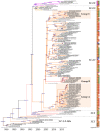

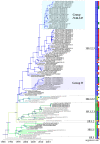
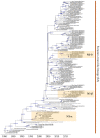
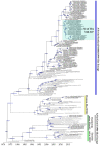
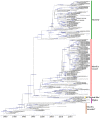
Similar articles
-
Genetic Variability among Swine Influenza Viruses in Italy: Data Analysis of the Period 2017-2020.Viruses. 2021 Dec 28;14(1):47. doi: 10.3390/v14010047. Viruses. 2021. PMID: 35062251 Free PMC article.
-
Major change in swine influenza virus diversity in France owing to emergence and widespread dissemination of a newly introduced H1N2 1C genotype in 2020.Virus Evol. 2024 Dec 14;11(1):veae112. doi: 10.1093/ve/veae112. eCollection 2025. Virus Evol. 2024. PMID: 39882310 Free PMC article.
-
Genetic and antigenic evolution of H1 swine influenza A viruses isolated in Belgium and the Netherlands from 2014 through 2019.Sci Rep. 2021 May 28;11(1):11276. doi: 10.1038/s41598-021-90512-z. Sci Rep. 2021. PMID: 34050216 Free PMC article.
-
[Swine influenza virus: evolution mechanism and epidemic characterization--a review].Wei Sheng Wu Xue Bao. 2009 Sep;49(9):1138-45. Wei Sheng Wu Xue Bao. 2009. PMID: 20030049 Review. Chinese.
-
Swine Influenza A Viruses and the Tangled Relationship with Humans.Cold Spring Harb Perspect Med. 2021 Mar 1;11(3):a038737. doi: 10.1101/cshperspect.a038737. Cold Spring Harb Perspect Med. 2021. PMID: 31988203 Free PMC article. Review.
Cited by
-
Genetic Variability among Swine Influenza Viruses in Italy: Data Analysis of the Period 2017-2020.Viruses. 2021 Dec 28;14(1):47. doi: 10.3390/v14010047. Viruses. 2021. PMID: 35062251 Free PMC article.
-
Eurasian 1C swine influenza A virus exhibits high pandemic risk traits.Emerg Microbes Infect. 2025 Dec;14(1):2492210. doi: 10.1080/22221751.2025.2492210. Epub 2025 May 7. Emerg Microbes Infect. 2025. PMID: 40207467 Free PMC article.
-
Trends in seroprevalence of influenza A virus infections in pigs in France (2008-2022).Porcine Health Manag. 2025 Jul 28;11(1):42. doi: 10.1186/s40813-025-00455-4. Porcine Health Manag. 2025. PMID: 40722119 Free PMC article.
-
Serological Evidence of Backyard Pig Exposure to Highly Pathogenic Avian Influenza H5N8 Virus during 2016-2017 Epizootic in France.Pathogens. 2021 May 18;10(5):621. doi: 10.3390/pathogens10050621. Pathogens. 2021. PMID: 34070190 Free PMC article.
-
Influenza viruses and coronaviruses: Knowns, unknowns, and common research challenges.PLoS Pathog. 2021 Dec 30;17(12):e1010106. doi: 10.1371/journal.ppat.1010106. eCollection 2021 Dec. PLoS Pathog. 2021. PMID: 34969061 Free PMC article. Review.
References
MeSH terms
Substances
LinkOut - more resources
Full Text Sources
Miscellaneous

